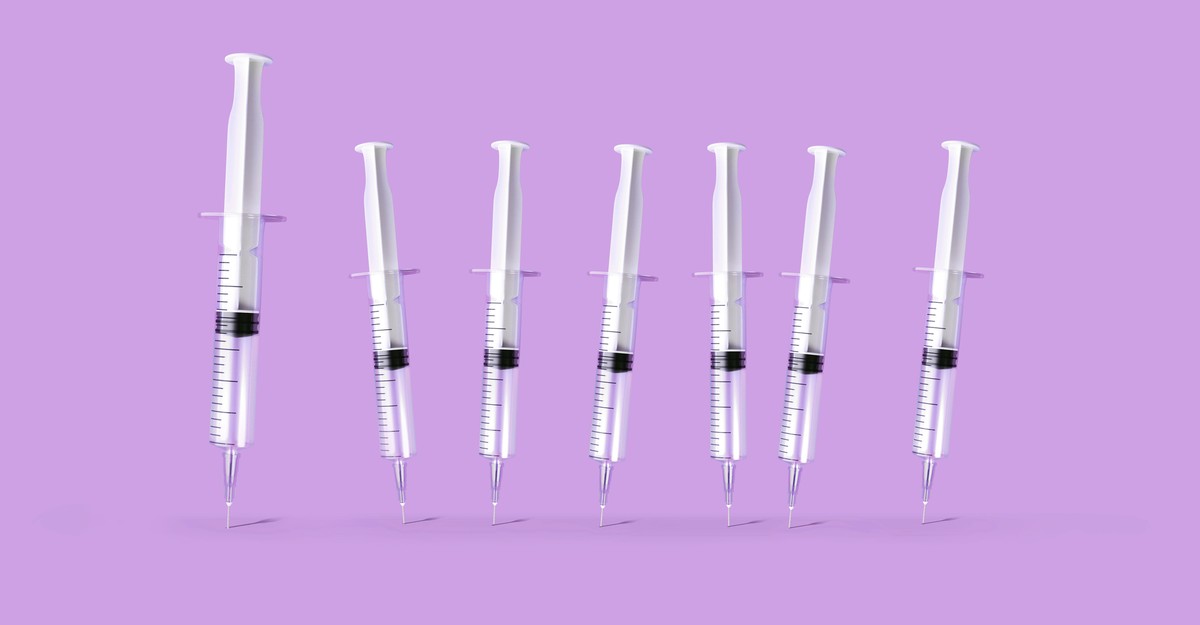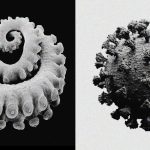In the two-plus years that COVID vaccines have been available in America, the basic recipe has changed just once. The virus, meanwhile, has belched out five variants concerning enough to earn their own Greek-letter names, followed by a menagerie of weirdly monikered Omicron subvariants, each seeming to spread faster than the last. Vaccines, which take months to reformulate, just can’t keep up with a virus that seems to reinvent itself by the week.
But SARS-CoV-2’s evolutionary sprint might not be the only reason that immunity can get bogged down in the past. The body seems to fixate on the first version of the virus that it encountered, either through injection or infection—a preoccupation with the past that researchers call “original antigenic sin,” and that may leave us with defenses that are poorly tailored to circulating variants. In recent months, some experts have begun to worry that this “sin” might now be undermining updated vaccines. At an extreme, the thinking goes, people may not get much protection from a COVID shot that is a perfect match for the viral variant du jour.
Recent data hint at this possibility. Past brushes with the virus or the original vaccine seem to mold, or even muffle, people’s reactions to bivalent shots—“I have no doubt about that,” Jenna Guthmiller, an immunologist at the University of Colorado School of Medicine, told me. The immune system just doesn’t make Omicron-focused antibodies in the quantity or quality it probably would have had it seen the updated jabs first. But there’s also an upside to this stubbornness that we could not live without, says Katelyn Gostic, an immunologist and infectious-disease modeler who has studied the phenomenon with flu. Original antigenic sin is the reason repeat infections, on average, get milder over time, and the oomph that enables vaccines to work as well as they do. “It’s a fundamental part,” Gostic told me, “of being able to create immunological memory.”
This is not just basic biology. The body’s powerful first impressions of this coronavirus can and should influence how, when, and how often we revaccinate against it, and with what. Better understanding of the degree to which these impressions linger could also help scientists figure out why people are (or are not) fighting off the latest variants—and how their defenses will fare against the virus as it continues to change.
The worst thing about “original antigenic sin” is its name. The blame for that technically lies with Thomas Francis Jr., the immunologist who coined the phrase more than six decades ago after noticing that the initial flu infections people weathered in childhood could bias how they fared against subsequent strains. “Basically, the flu you get first in life is the one you respond to most avidly for the long term,” says Gabriel Victora, an immunologist at Rockefeller University. That can become somewhat of an issue when a very different-looking strain comes knocking.
In scenarios like these, original antigenic sin may sound like the molecular equivalent of a lovesick teen pining over an ex, or a student who never graduates out of immunological grade school. But from the immune system’s point of view, never forgetting your first is logically sound. New encounters with a pathogen catch the body off guard—and tend to be the most severe. A deep-rooted defensive reaction, then, is practical: It ups the chances that the next time the same invader shows up, it will be swiftly identified and dispatched. “Having good memory and being able to boost it very quickly is sometimes a very good thing,” Victora told me. It’s the body’s way of ensuring that it won’t get fooled twice.
These old grudges come with clear advantages even when microbes morph into new forms, as flu viruses and coronaviruses often do. Pathogens don’t remake themselves all at once, so immune cells that home in on familiar snippets of a virus can still in many cases snuff out enough invaders to prevent an infection’s worst effects. That’s why even flu shots that aren’t perfectly matched to the season’s most prominent strains are usually still quite good at keeping people out of hospitals and morgues. “There’s a lot of leniency in how much the virus can change before we really lose protection,” Guthmiller told me. The wiggle room should be even bigger, she said, with SARS-CoV-2, whose subvariants tend to be far more similar to one another than, say, different flu strains are.
With all the positives that immune memory can offer, many immunologists tend to roll their eyes at the negative and bizarrely moralizing implications of the phrase original antigenic sin. “I really, really hate that term,” says Deepta Bhattacharya, an immunologist at the University of Arizona. Instead, Bhattacharya and others prefer to use more neutral words such as imprinting, evocative of a duckling latching onto the first maternal figure it spots. “This is not some strange immunological phenomenon,” says Rafi Ahmed, an immunologist at Emory University. It’s more a textbook example of what an adaptable, high-functioning immune system does, and one that can have positive or negative effects, depending on context. Recent flu outbreaks have showcased a little bit of each: During the 2009 H1N1 pandemic, many elderly people, normally more susceptible to flu viruses, fared better than expected against the late-aughts strain, because they’d banked exposures to a similar-looking H1N1—a derivative of the culprit behind the 1918 pandemic—in their youth. But in some seasons that followed, H1N1 disproportionately sickened middle-aged adults whose early-life flu indoctrinations may have tilted them away from a protective response.
The backward-gazing immune systems of those adults may have done more than preferentially amplify defensive responses to a less relevant viral strain. They might have also actively suppressed the formation of a response to the new one. Part of that is sheer kinetics: Veteran immune cells, trained up on past variants and strains, tend to be quicker on the draw than fresh recruits, says Scott Hensley, an immunologist at the Perelman School of Medicine at the University of Pennsylvania. And the greater the number of experienced soldiers, the more likely they are to crowd out rookie fighters—depriving them of battlefield experience they might otherwise accrue. Should the newer viral strain eventually return for a repeat infection, those less experienced immune cells may not be adequately prepared—leaving people more vulnerable, perhaps, than they might otherwise have been.
Some researchers think that form of imprinting might now be playing out with the bivalent COVID vaccines. Several studies have found that the BA.5-focused shots are, at best, moderately more effective at producing an Omicron-targeted antibody response than the original-recipe jab—not the knockout results that some might have hoped for. Recent work in mice from Victora’s lab backs up that idea: B cells, the manufacturers of antibodies, do seem to have trouble moving past the impressions of SARS-CoV-2’s spike protein that they got from first exposure. But the findings don’t really trouble Victora, who gladly received his own bivalent COVID shot. (He’ll take the next update, too, whenever it’s ready.) A blunted response to a new vaccine, he told me, is not a nonexistent one—and the more foreign a second shot recipe is compared with the first, the more novice fighters should be expected to participate in the fight. “You’re still adding new responses,” he said, that will rev back up when they become relevant. The coronavirus is a fast evolver. But the immune system also adapts. Which means that people who receive the bivalent shot can still expect to be better protected against Omicron variants than those who don’t.
Historical flu data support this idea. Many of the middle-aged adults slammed by recent H1N1 infections may not have mounted perfect attacks on the unfamiliar virus, but as immune cells continued to tussle with the pathogen, the body “pretty quickly filled in the gaps,” Gostic told me. Although it’s tempting to view imprinting as a form of destiny, “that’s just not how the immune system works,” Guthmiller told me. Preferences can be overwritten; biases can be undone.
Original antigenic sin might not be a crisis, but its existence does suggest ways to optimize our vaccination strategies with past biases in mind. Sometimes, those preferences might need to be avoided; in other instances, they should be actively embraced.
For that to happen, though, immunologists would need to fill in some holes in their knowledge of imprinting: how often it occurs, the rules by which it operates, what can entrench or alleviate it. Even among flu viruses, where the pattern has been best-studied, plenty of murkiness remains. It’s not clear whether imprinting is stronger, for instance, when the first exposure comes via infection or vaccination. Scientists can’t yet say whether children, with their fiery yet impressionable immune systems, might be more or less prone to getting stuck on their very first flu strain. Researchers don’t even know for certain whether repetition of a first exposure—say, through multiple doses of the same vaccine, or reinfections with the same variant—will more deeply embed a particular imprint.
It does seem intuitive that multiple doses of a vaccine could exacerbate an early bias, Ahmed told me. But if that’s the case, then the same principle might also work the other way: Maybe multiple exposures to a new version of the virus could help break an old habit, and nudge the immune system to move on. Recent evidence has hinted that people previously infected with an early Omicron subvariant responded more enthusiastically to a bivalent BA.1-focused vaccine—available in the United Kingdom—than those who’d never encountered the lineage before. Hensley, at the University of Pennsylvania, is now trying to figure out if the same is true for Americans who got the BA.5-based bivalent shot after getting sick with one of the many Omicron subvariants.
Ahmed thinks that giving people two updated shots—a safer approach, he points out, than adding an infection to the mix—could untether the body from old imprints too. A few years ago, he and his colleagues showed that a second dose of a particular flu vaccine could help shift the ratio of people’s immune responses. A second dose of the fall’s bivalent vaccine might not be practical or palatable for most people, especially now that BA.5 is on its way out. But if next autumn’s recipe overlaps with BA.5 in ways that it doesn’t with the original variant—as it likely will to at least some degree, given the Omicron lineage’s continuing reign—a later, slightly different shot could still be a boon.
Keeping vaccine doses relatively spaced out—on an annual basis, say, à la flu shots—will likely help too, Bhattacharya said. His recent studies, not yet published, hint that the body might “forget” old variants, as it were, if it’s simply given more time: As antibodies raised against prior infections and injections fall away, vaccine ingredients could linger in the body rather than be destroyed by prior immunity on sight. That slightly extended stay might offer the junior members of the immune system—lesser in number, and slower on the uptake—more of an opportunity to cook up an Omicron-specific response.
In an ideal world, researchers might someday know enough about imprinting to account for its finickiness whenever they select and roll out new shots. Flu shots, for instance, could be personalized to account for which strains babies were first exposed to, based on birth year; combinations of COVID vaccine doses and infections could dictate the timing and composition of a next jab. But the world is not yet living that reality, Gostic told me. And after three years of an ever-changing coronavirus and a fluctuating approach to public health, it’s clear that there won’t be a single vaccine recipe that’s ideal for everyone at once.
Even Thomas Francis Jr. did not consider original antigenic sin to be a total negative, Hensley told me. According to Francis, the true issue with the “sin” was that humans were missing out on the chance to imprint on multiple strains at once in childhood, when the immune system is still a blank slate—something that modern researchers could soon accomplish with the development of universal vaccines. Our reliance on first impressions can be a drawback. But the same phenomenon can be an opportunity to acquaint the body with diversity early on—to give it a richer narrative, and memories of many threats to come.






